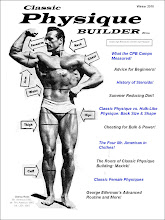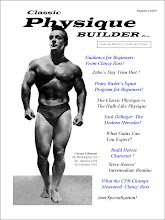
(Above: Classic Physique Builder Champ -
Alan Stephan, Mr. America 1946)
Here is a no nonsense, classic routine for beginners by Alan Stephan for building mass that is right out of the pre-roid, Golden Age!
In an article in
Your Physique magazine (Sept 1950 issue), Alan talks about the general rules for a beginner to follow in putting together a bulk building program. He said "All you need to do is follow the right exercises, eat plenty of nourishing food and get as much rest and relaxation on your non training days as you possibly can." So, in other words, he is talking about proper training, proper nutrition, and proper rest! Notice that he doesn't say anything about needing special supplements (no NO boosters, pump enhancers, creatine, or even protein powder)!
In talking about mass building programs, Alan goes on, "Let's deal with the right exercises first. If you build a schedule around either the deep knee bend or the dead lift and take it from there, you are on the right track." So in 1947, they knew well that including the big exercises like squats and deadlifts in a routine kick started the growth mechanism! They didn't have to wait until scientific studies showed that such exercises increased the level of testosterone in the blood! They knew it worked from their own experimentation and results!
Alan continues, "The fundamental movements such as the supine press or any of its variants - bench presses of incline presses - , curls, rowing motions, squats, or dead lifts or leg presses combined with sets of bent arm pullovers, are the best." What Alan is describing here is basically the approach advocated by Peary Rader (the founder of Iron Man magazine).
Peary Rader and many of the Golden Age champs (like Ed Yarick, Steve Reeves, and George Eiferman) were big believers in the high repetition breathing squat-pullover combination. They believed that this combination really kick started the growth mechanism and also expanded the rib cage. It is such training that gave the Golden Age champs that more massive upper body impressiveness that you don't see among most of today's drug-free, natural bodybuilders (ever notice how shallow their upper bodies look these days?). If you look at Steve Reeve's beginning and intermediate routines (which we have posted previously), you can see that Steve employed this breathing squat-pullover combo in his training.
Alan is also describing the basic, "compound exercise philosophy" of having a short routine consisting of compound exercises (multi-joint exercises that work large groups of muscles) rather than a longer routine using isolation exercises (exercises which work only a single muscle or muscle group across a single joint). This philosophy was also a centerpiece of the Rader approach.
Here is the example routine that Alan provides:
1. Bench Press 8-12 reps
2. Barbell Curls 8-12 reps
3. Breathing Squats 20 reps (1st set), 10 reps (remaining sets)
4. Bent Arm Pullovers 20 reps (superset with each set of breathing squats)
5. Bent Over Rows 8-12 reps
That's it! However, we (CPB) would add a sixth exercise: calf raises for 20 reps.
Rest between sets: 2-3 minutes! (Yes, that's right! You'll need that much time to recouperate between sets so that you can use heavier weights)
This is a classic abbreviated routine for mass building! Abbreviated routines are routines with a relative small number of exercises that work most of the body. This type of full-body, abbreviated routine allows you to use maximum energy in your workout and get more recovery time between workouts (you will have more total non-workout days for complete rest than modern, exotic split training that keeps you in the gym 4-6 days per week).
For the beginner - do 1 set of each exercise for the 1st month, 2 sets the second month, 3 sets the third month. Workout twice a week (e.g., Tue and Sat, or Mon and Fri). For the 1st workout, use light weights just to get used to the exercises. For the second workout, try to determine for each exercise the amount of weight you can handle to complete 8 reps (with good form) and no more. Then, at each successive workout, try to increase your reps by 1 or 2, until you reach the top of the rep range. At that point, add a little weight to the bar. Continue in this fashion for the course. Keep your focus on this process of increasing reps, then increasing poundages. This is how you use the principle of "progressive resistance." It is this process of gradually increasing your strength and poundages that will result in larger muscles!
For the breathing squats, use proper squat form, take one breath between each of the first 5 reps, then after that take 2-3 deep breaths in between repititions until you reach 20 reps. By the end of the set, you should be panting! In month 2, your second set of breathing squats should only be 10 reps. The same for month 3 (only the first set is ever done for 20 reps). Each set is to be immediately followed (supersetted) with light barbell pullovers. Use no more than 20 lbs total (including the bar weight). The point is to stretch the rib cage (not to use maximum weights to exercise the muscles). Bend the arms slightly and try to really stretch your rib cage.
Here's Alan's advice on diet: "Don't forget to drink lots of milk and eat plenty of good food such as fresh vegetables and meat, eggs [whole], cheese, and butter. Fruits and salads are also good.
On rest, he advises: "An important factor in a weight gaining programme is to rest all you can on non-training days. Whatever you do, don't play other games [sports] and expect to make progress. You must rest completely between workouts and get a good night's rest each and every night of the week.
Alan's final advice: "Work hard on your schedule [routine], be persistant and determined and you are going to have little or no trouble in gaining bulk!
For the intermediate - This program of Alan's is also good for intermediate CPB trainers. If you are an intermediate trainer (have more than 3 months experience following a proper course but have not yet reached your size goals), then you can use the above program as well. Just start with 3 sets for all exercises following the guidelines above and stay with 3 sets for the duration of the course. Take a week lay off between each month. Your major goal for this course is to concentrate on increasing your poundages - this is the key to growth! By the end of each month, you should see a significant increase in strength (indicated by your training log records of reps and poundages) and this will correspond to a noticeable increase in muscle size!
So there you have it - a classic, Golden Age Bulk (Mass) Building Program - straightforward, no nonsense, - just a train big, eat big, rest big, and grow big approach!
-
CPB
P.S. For a free 1 year subscription to
Classic Physique Builder (
CPBzine) - a pdf zine patterned after the pre-roid, Golden Age muscle mags (of the 40s and 50s) - just email your name, the name of your city (not your address), state (or province), and country to
cpbzine@gmail.com. That's it! Any info you send us will be strictly confidential. We don't share our info with anyone, so you won't get on any lists or receive any unwanted, automated emails (even from us)!












